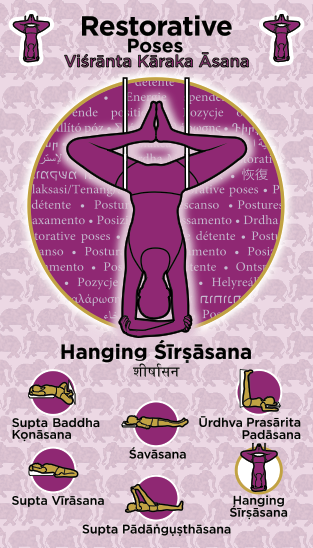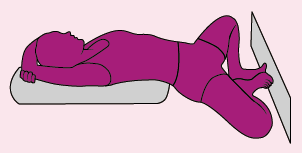YOGA ASANAS :
“RESTORARIVE POSES” FAMILY
In the “Restorative Poses” family,
each of the six Asanas is featured using the same design
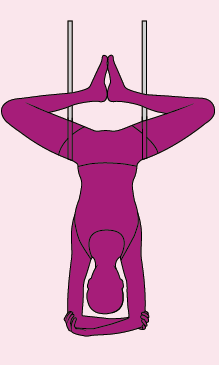
Śirṣāsana on the rope
– Page 240, ( “Iyengar Yoga for motherhood” Geeta S. Iyengar, Rita Keller, Kerstin Khattab, Sterling, New York, London ).
See «normal» classical posture:
# 74, plates 176 to 218, page 179 ( «Light on Yoga» BKS. Iyengar. Aquarian/Thorsons. Harper Collins India. Schocken books, New York ).
# 38, plates 69/70, page 180 ( «Yoga, a gem for women», Geeta S Iyengar. Allied publishers, India ).
Śirṣa: The head.
This is the head balance, but hanging from ropes. Legs, here in Baddha Koṇāsana, can be arranged in various ways. Inverted poses are of great help to strengthen the nervous and endocrinal systems. Check up though with your Yoga teacher for counter indications.
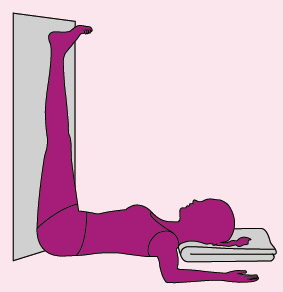
Ūrdhva prasārita pādāsana
Ūrdhva Prāsarita Pādāsana ( supported )
# 106, plates 276/279, page 240 ( «Light on Yoga» BKS. Iyengar. Aquarian/Thorsons. Harper Collins India. Schocken books, New York ).
# 58, plates 107/109 , page 217 ( «Yoga, a gem for women», Geeta S Iyengar. Allied publishers, India ).
But legs supported against a wall, with folded arms, elbows level with shoulders.
Ūrdhva : Upright, above.
Prāsarita : Extended, stretched out.
Pāda : Foot.

Śavāsana/Mṛtāsana
# 200, plate 592, page 423 ( «Light on Yoga» BKS. Iyengar. Aquarian/Thorsons. Harper Collins India. Schocken books, New York ).
# 91, plate 212 , page 290 ( «Yoga, a gem for women», Geeta S Iyengar. Allied publishers, India).
– Plates 151/190, pages 233 ( « Light on Pranayama » BKS. Iyengar, Harper Collins India ).
Śava, or Mṛtā : Corpse.
In each pose/Āsana, a specific element ( See the Pāncāmahābhūtaḥ card from the Patañjali family ) is increased, which has an effect on the element related chakra.
The five elements, or Pāncāmahābhūtaḥ, are in relationship with our existence down on this earth, as manifested beings ( or Liṅga ), and mostly so Pṛthvi/earth, Tejas/fire, Āp/water and Vāyu/air.
In fact, one could consider on one hand the four elements Fire/Earth/Water/Air, and Ākāsa/Ether/Space on the other hand.
The elements are the expression of the ever changing transformation that undergo every existing thing or being in this manifested world of ours : Pick up a wooden stick and leave it outside at night. The next morning, although it will be the same stick, it will be nevertheless different. It will be more wet and heavier. Keep it inside and the air will dry it up, making it lighter. Manifestation and change go together.
The Yogi yearns for stability ( see Samasthiti/Tāḍāsana ), to get established beyond change, to get loose from Pāncāmahābhūtaḥ, the five elements. The way of reintegration goes through Ākāsa.
Ākāsa, ether or fith element permeates everything, even the densest lead. It is more in relationship with the state of Aliṅga, or not manifested. In Śavāsana, the constitutive elements desagregate, and Ākāsa/Ether increases.
The related sense with Ākāsa/Ether is hearing. Inner hearing, withdrawal of senses, self observation, meditation lead to Samādhi.
Supta Baddha Koṇāsana
See Baddha Koṇāsana
# 44, plates 101/103, page 128 ( «Light on Yoga» BKS. Iyengar. Aquarian/Thorsons. Harper Collins India. Schocken books, New York ).
# 24, plates 38/39, page 156 ( «Yoga, a gem for women», Geeta S Iyengar. Allied publishers, India ).
Supta : Sleeping, on the back.
Baddha : Caught, restrained, bound, firm.
Koṇa : Angle
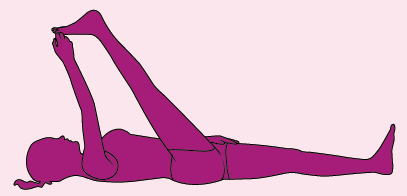
Supta Pādāṅguṣṭhāsana
# 108, plates 284/287, page 244 ( «Light on Yoga» BKS. Iyengar, Harper Collins India ).
# 62, plates 117/119, page 224 ( «Yoga, a gem for women», Geeta S Iyengar. Allied publishers, India ).
Supta : Lying down.
Pāda : Foot.
Anguṣṭha : Big toe.
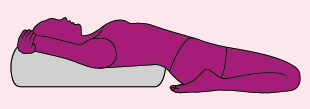
Supta Vīrāsana
# 41, plates 93/96, page 124 ( «Light on Yoga» BKS. Iyengar. Aquarian/Thorsons. Harper Collins India. Schocken books, New York ).
# 23, plates 46/49, page 64 ( « The illustrated light on Yoga » BKS Iyengar. Harper Collins India ).
# 33, plate 58, page 172 ( «Yoga, a gem for women», Geeta S Iyengar. Allied publishers, India ).
Supta : Sleeping, laying on the back.
Vīra : Hero, champion, warrior ( see «Vīrabhadra»).
